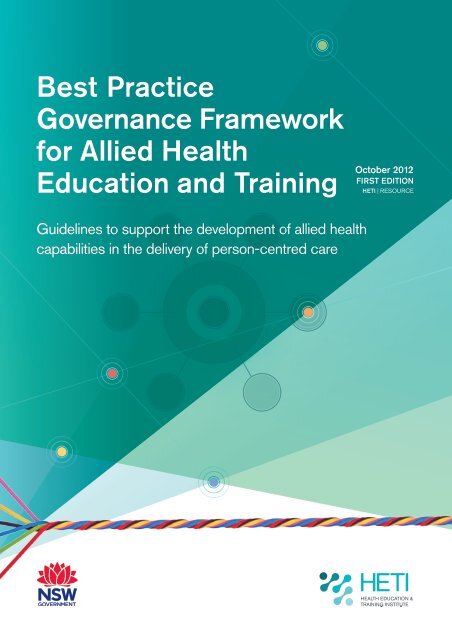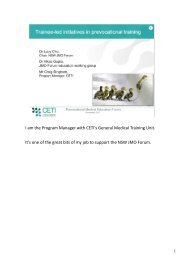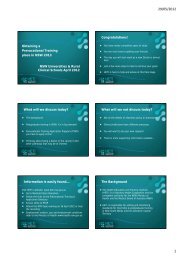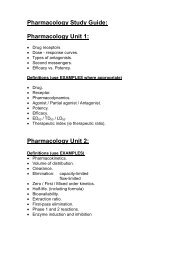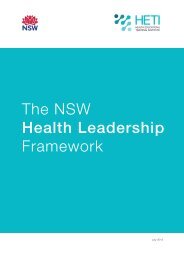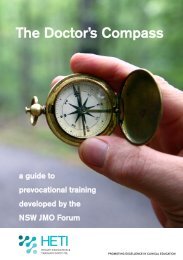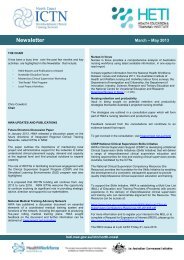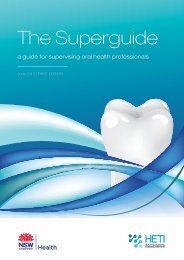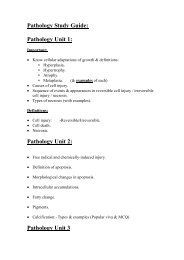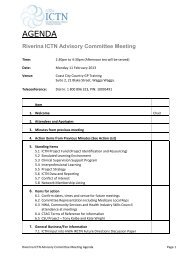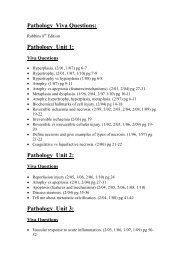Open - HETI
Open - HETI
Open - HETI
- No tags were found...
You also want an ePaper? Increase the reach of your titles
YUMPU automatically turns print PDFs into web optimized ePapers that Google loves.
Best PracticeGovernance Frameworkfor Allied HealthEducation and TrainingGuidelines to support the development of allied healthcapabilities in the delivery of person-centred careLook for updates on the website:© <strong>HETI</strong> 2012 www.heti.nsw.gov.au
Health Education and Training Institute (<strong>HETI</strong>)Building 12Gladesville HospitalGLADESVILLE NSW 2111Tel. (02) 9844 6551Fax. (02) 9844 6544www.heti.nsw.gov.auinfo@heti.nsw.gov.auPost: Locked Bag 5022GLADESVILLE NSW 1675National Library of Australia Cataloguing-in-Publication entryTitle: Best practice governance framework for allied health education and training: guidelines tosupport the development of allied health capabilities in the delivery of person-centred care/HealthEducation and Training Institute.Best Practice Governance Framework for Allied Health Education and TrainingSHPN: (<strong>HETI</strong>) 120306ISBN: 9780987193698 (pbk.)Notes: Includes bibliographical references.Subjects: Allied health personnel – Training of – New South Wales.Medical personnel – Training of – New South Wales.Other Authors/Contributors: Health Education and Training Institute.Dewey Number: 610.715Suggested citation:Health Education and Training Institute. Best Practice Governance Framework for Allied Health Educationand Training: Guidelines to support the development of allied health capabilities in the delivery of personcentredcare. Sydney: <strong>HETI</strong>, 2012.This work is copyright. It may be reproduced in whole or in part for study or training purposes subject tothe inclusion of an acknowledgement of the source. It may not be reproduced for commercial usage or sale.Reproduction for purposes other than those indicated requires written permission from <strong>HETI</strong>.©<strong>HETI</strong> October 2012.iiFor further copies of this document, please contact <strong>HETI</strong>, or download a digital copy from the <strong>HETI</strong>website: www.heti.nsw.gov.au<strong>HETI</strong>
ForewordThe Health Education and Training Institute (<strong>HETI</strong>) is pleased to present TheBest Practice Governance Framework for Allied Health Education and Training.This is a reference document written to support establishment of local systemsof governance for allied health education and training within Local HealthDistricts and Specialty Networks.It was developed by the <strong>HETI</strong> Allied Health Portfolio in collaboration with theNSW Directors of Allied Health and <strong>HETI</strong> Allied Health Advisory Committeewith feedback provided from Local Health Districts and Speciality NetworkChief Executives and allied health professionals, educators, and managers.Good governance is considered critical to achieving a health service that is responsive to patient/client care needs and the education and training needs of its staff, in order to deliver high qualityand safe patient care to the people of NSW.<strong>HETI</strong> is an organisation committed to developing a world class NSW health workforce throughexcellence in education and training. This document will provide evidence based guidelines topromote best practice within NSW Health agencies.I look forward to ongoing collaboration with the many dedicated allied health professionals,educators, managers and executives working in the NSW Health system to establish and enhancesystems of governance for allied health education and training locally.<strong>HETI</strong> Chief ExecutiveHeather GrayBest Practice Governance Framework for Allied Health Education and Training <strong>HETI</strong>iii
AcknowledgementsThis project was overseen by the <strong>HETI</strong> Allied Health Advisory Committee withdevelopment completed by a working group consisting of the <strong>HETI</strong> Allied HealthPortfolio and representatives of the NSW Directors of Allied Health Committee.Best Practice Governance Framework for Allied Health Education and Training Working Group:Jacqueline DominishSenior Program OfficerAllied Health Education and TrainingHealth Education and Training InstitutePatricia BraddChair NSW Allied Health Directors CommitteeDirector Allied HealthSouth Eastern Sydney Local Health DistrictRichard CheneyDirector Allied HealthWestern NSW Local Health DistrictDaniella PfeifferSenior Program OfficerAllied Health Education and TrainingHealth Education and Training InstituteGrainne O’LoughlinDirector Allied HealthSt Vincent’s Health NetworkVirginia BinnsClinical Program DirectorCommunity, Ambulatory, Rehabilitation,Population and Allied HealthSydney Children’s HospitalAcknowledgementsBest Practice Governance Framework for Allied Health Education and TrainingDanielle CollinsProject Coordinator on Secondment<strong>HETI</strong> Allied Health PortfolioOccupational TherapistPrince of Wales HospitalSouth East Sydney LHDNSW Directors of Allied Health Committee.Design by Clik CreativeThe <strong>HETI</strong> Best Practice Governance Framework for Allied Health Education and TrainingWorking Group and Allied Health Advisory Committee acknowledges and thanks the manyallied health professionals and colleagues who provided constructive, useful and relevantfeedback on the state- wide consultation draft.iv<strong>HETI</strong>
ContentsForewordiiiAcknowledgementsivBackground and context 2Allied Health in NSW Health 3Introduction 4What is a learning organisation? 5Using the framework 6Roles and responsibilities 8Best practice guidelines 10Appendices 23Appendix A – Self assessment checklists 24Appendix B – Allied Health Industrial Awards in NSW 30Appendix C – Links to professional boards and associations 31Appendix D – Other links for allied health 34Bibliography of supporting documents for best practice guidelines 35Reference List 40Best Practice Governance Framework for Allied Health Education and Training <strong>HETI</strong>1
Background and context“Clinical Governance is the term used to describe a systematic approach to maintaining andimproving the quality of patient care within a health system. It is about the ability to produceeffective change so that high quality care is achieved. It requires clinicians and administratorsto take joint responsibility for making sure this occurs. When Clinical Governance is effective,it has the potential to:• make positive changes you want to see happen;• improve the quality of care for patients; and• provide a better experience for staff”.(New South Wales Ministry of Health, 2011)Education and training is a critical component of the overall system of clinical and corporategovernance of health care organisations (Braithwaite & Travaglia, 2008). It is a transition point whichbridges the gap between the generation and application of knowledge. As identified in the CorporateGovernance and Accountability Compendium for NSW Health, a core principle of good governanceis to ensure the NSW Health workforce have the capacity and capability to provide effective and safehealth services (NSW Department of Health, 2005).The term governance in the context of this document refers to a systematic approach to maintainingand improving the quality of education and training for allied health professionals across NSW Health.Best Practice Governance Framework for Allied Health Education and TrainingHealth systems and population needs are in a continual state of change. To keep up with thesechanges, allied health professionals must engage in lifelong learning and draw from practice-basedexperience and current evidence to remain competent to practise. By ensuring that allied healthprofessionals are supported to engage in lifelong learning and continuing professional development,health care organisations can be confident that they are employing a workforce capable of deliveringperson-centred care and therefore enhancing care outcomes.A number of consultations were held in 2011 by the <strong>HETI</strong> Allied Health Portfolio with allied healthdirectors, educators and clinicians. During these consultations it became evident that a set of bestpractice guidelines would be of benefit to provide guidance to allied health professionals, educators,managers and executives on building local systems of governance to support allied health educationand training within Local Health Districts (LHDs) and Specialty Networks.This framework has been developed by the <strong>HETI</strong> Allied Health Portfolio in collaboration with theNSW Allied Health Directors Committee and <strong>HETI</strong> Allied Health Advisory Committee. It is hoped byapplying the principles and guidelines outlined within this framework that health services will supportthe development of allied health capabilities in the delivery of person-centred care and promote aculture of lifelong learning and development of its staff. This will ensure that health professionals havethe necessary up-to-date skills and knowledge to provide high quality and safe care to the people ofNSW.2<strong>HETI</strong>
Allied Health in NSW HealthAllied health professionals:• Hold tertiary qualifications• Hold relevant registration, licence or accreditation to practise, and/or eligibility for membershipwith professional associations• Provide a range of therapeutic and diagnostic services in either the public, primary health orprivate health care sector• Apply their skills and knowledge to restore and maintain optimal physical, sensory,psychological, cognitive and social function with their clients/patients• Use a range of complex skills including specific professional clinical skills as well ascommunication, clinical reasoning, reflection and evidence-based practice skills• Work in teams, including multidisciplinary, interdisciplinary, and transdisciplinary teams• Are allied or align with each other and other members of the health professional workforce,their patient/clients, their families, carers and community, working across the health system.NSW Health allied health professions*Art TherapyAudiologyCounsellingDiversional TherapyExercise PhysiologyGenetic CounsellingMusic TherapyNuclear Medicine TechnologyNutrition & DieteticsOccupational TherapyOrthopticsOrthotics & ProstheticsPharmacyPhysiotherapyPlay Therapy/Child Life TherapyPodiatryPsychologyRadiation TherapyRadiographySexual Assault WorkersSocial WorkSpeech PathologyWelfare Officer* Information provided by Brenda McLeod, Chief Allied Health Officer, Workforce Development and Innovation Branch,NSW Ministry of Health, as per NSW Treasury Codes Classification System.Best Practice Governance Framework for Allied Health Education and Training <strong>HETI</strong>3
IntroductionThis framework has been developed to provide a set of best practice guidelines for allied healthprofessionals, educators, managers and executives to establish or enhance systems of governancefor allied health education and training within LHDs and Specialty Networks.A guideline as defined by the NSW Health Policy Distribution System is any document thatestablishes best practice for NSW Health agencies (NSW Department of Health, 2009).This document has been developed following a review of existing accreditation, policy frameworksand current evidence to support the development of allied health capabilities in the delivery ofperson-centred care through the creation of learning organisations and promotion of a culture oflifelong learning. The guidelines are based on a set of key overarching principles of education andtraining as outlined below.Key principlesEducation and Training should be:• Driven by patient/client needsEducation and Training should lead to:• Improved patient/client careBest Practice Governance Framework for Allied Health Education and Training• Aimed at the provision of high quality andsafe patient/client care that is evidencebased• A shared responsibility among theorganisation, clinicians and managers• Embedded as core business within healthcare organisations• Aligned with state and national priorities withjoint planning occurring between health andeducational institutions and stakeholders• Supported through the development oflearning organisations.• Skilled, confident and competent clinicians• An organisation that is responsive to theeducation and training needs of its staff• An organisation that has appropriateeducation peak committees in place• Partnerships that are developed betweenLHDs/Specialty Networks, VocationalEducation and Training sector, tertiaryinstitutions, research institutes, Pillars,Ministry of Health• A culture of learning, teaching andprofessional development embeddedwithin organisational values.4<strong>HETI</strong>
What is a learning organisation?According to the NSW Ministry of Health:“A learning organisation is one which has structures and processes in place to encourage andreward continuous learning. A learning organisation recognises people as its most valuable asset.In a learning organisation, every individual is encouraged and supported to locate and create his/her own learning opportunities. The organisation facilitates access to relevant opportunities byestablishing structures and processes which enable staff to learn from actual work situations.”(NSW Department of Health, 2006, p4).Additional characteristics of learning organisations as outlined in the literature include the willingnessof the organisation to learn from its own experiences, learning from other organisations andencouraging staff from the “bottom up” as well as the “top down” to provide feedback and inputinto improvement of processes and initiatives (Braithwaite 2008; Mohr, 2005; Senge, 1990). In healthservices this is essential to ensure that the organisation is responsive to both patient/client careneeds and the education and training needs of its staff in order to ensure the delivery of safe andhigh quality patient care.Who is this framework for?This framework has been developed for use by the following individuals in an effort to improvestandards and consistency of education and training for allied health professionals working inNSW Health:• Allied health professionals• Allied health educators• Managers/team leaders of allied health professionals• Allied health directors• Health service managers• Learning and Development units• LHD and Specialty Network Executives and BoardsThis framework, while being predominantly targeted at the education and training of alliedhealth professionals, is also applicable to allied health assistants employed within NSW Health.Best Practice Governance Framework for Allied Health Education and Training <strong>HETI</strong>5
Using the framework“Being person centred involves valuing staff as well as patients as persons, with all theirdiversity. It encompasses the interpersonal skills required to achieve this, and to instill faith andrespect. Person-centred relationships are built on mutual trust, understanding and the sharingof collective knowledge; are interrelated with values, caring processes and the environment ofcare.” “It is enabled by cultures of empowerment.” (Manley, Sanders, Cardiff & Webster, 2011, p. 10)There are six best practice guidelines which enable person-centred care through robust systemsof governance of allied health education and training.No12345Best Practice GuidelineHealth services have a robust system of governance for education and training for alliedhealth professionals.Planning of education and training for allied health professionals is driven by the healthcare needs of the population and local service requirements.Structures and processes are in place and tools are available to support learning, teachingand continuing professional development of allied health professionals in the workplace.Allied health professionals have access to clinical supervision appropriate to theirqualifications and level of experience.Stakeholder relationships pertaining to allied health education and training are developedand fostered.6 Allied health professionals are advocates for their education and training needs.Best Practice Governance Framework for Allied Health Education and Training6<strong>HETI</strong>Under each guideline is a brief description followed by a set of indicators of achievement andpractice examples attached to specific stakeholder groups. These are as follows:IndividualsOutlines the expectations of individual allied health professionals to meet the guideline. Theseexpectations should be read in conjunction with the relevant industrial award specific to theparticular individual and their profession. For a full list of awards relevant to allied healthprofessionals in NSW Health refer to Appendix B.ManagersOutlines the expectations of managers/leaders to support achievement of the guideline. Managersand leaders should also refer to the requirements outlined in the individual expectations and theirrelevant industrial award in relation to their own education.OrganisationOutlines the expectations of the Chief Executive and Board of the LHD/Specialty Network tosupport achievement of the guideline.OutcomesThe guidelines also have longterm outcomes attached to them relating to the benefits of achievingeach guideline, either for patients/clients, clinicians or the overall organisation.Self assessment checklistsContained within Appendix A are self assessment checklists which can be used by individuals,managers or the organisation to assess current levels of achievement.Bibliography of supporting documentsLists the literature, existing policy and accreditation frameworks which support each guideline.
Key Elements of the FrameworkThis diagram illustrates key elements of the Best Practice Governance Framework for Allied HealthEducation and Training. The guidelines are informed by the key principles found on page 4 and canbe used independently of each other, but would also be considered collectively by an organisation to:• transfer and exchange knowledge into practice• achieve high standards of patient/client care• promote a culture of life long learning.Figure 1: Key elements of the Best Practice Governance Framework for Allied Health Education and TrainingSystem ofGovernanceLearning,Teachingand CPDQuality and SafetyKnowledge Transfer and ExchangeORGANISATIONCLINICIANAdvocacyCollaborativeRelationshipsEvidence BasedPracticeClinicalConfiidencePersonCentredCareRCritical eflectionCAPABILITYMANAGERSkills and CompetenceLife Long LearningClinicalSupervisionHealth CareNeeds of thePopulationBest Practice Governance Framework for Allied Health Education and Training <strong>HETI</strong>7
ManagersExpectationsof managers andleaders to supportachievement of theguidelineOrganisationExpectations of theChief Executive andBoard to supportachievement of theguideline• There is evidence of planning of team/department/service education and training activities that reflectsinformation captured from various sources including datamanagement systems, patient/client satisfaction surveysand individual learning and development plans.• Learning and development plans are incorporated intothe managing for performance process to ensure thatstaff are equipped to meet patient/client and servicedelivery requirements.• Clinical indicators are in place and reflect evidencebasedpractice.• Development of team/department/service educationis informed by service priorities and new/changing/improved clinical best practice.• Data management systems are in place to capturepatient trends throughout the care continuum (inpatient,outpatient and community), enabling managers to planeducation services that target patient/client needs(Braithwaite & Travaglia, 2008).• Key organisational information is gathered, analysed andutilised to inform improvements using education andtraining.• New services are planned with consideration of skill mixand education and training needs of staff.• Processes are in place to ensure service continuitywhen allied health professionals are attending educationand training.• The needs of patient/client groups are identified andused to inform organisational planning and educationalstrategy.• Local data is collected, analysed and utilised from thefollowing sources:• Clinical and non-clinical activity data collection systems• Incident monitoring• Quality improvement activities• Clinical indicators• Complaints management processes• Learning and development plans• Patient/client satisfaction surveys• Use of patient/client data (e.g. demographics, case mix,disease profile).• Infrastructure is in place to support use of data managementsystems including access to computer hardware, IT supportand training of allied health professionals.• Critical incident reviews include recommendations regardingeducation and training of staff, and allocation of fundingnecessary to support implementation.• Allied health professionals employed in newly establishedservices receive appropriate education and training relevant toservice delivery requirements.• Information is gathered from patient/client groups and used toinform education activities, including demographics, case mix,disease profiles and satisfaction with care delivery.• Partnering with Pillars occurs to share specialist-specific datathat can be used to inform education and training needs at theLocal Health District/Specialty Network level.Outcome• Patients/clients are treated by skilled professionals and teams with current knowledge and skills to meet their health care needs.Please refer to the bibliography on page 35 for supporting documents.13Best Practice Governance Framework for Allied Health Education and Training <strong>HETI</strong>
<strong>HETI</strong>14Best Practice Governance Framework for Allied Health Education and TrainingLearning,Teachingand CPDBest Practice Governance GuidelinesGuideline 3 – Learning, Teaching and CPDStructures and processes are in place and tools are available to support learning, teachingand continuing professional development (CPD) of allied health professionals in the workplace• Engagement in learning, teaching and CPD in the workplace is a shared responsibility between individuals, managers and organisations.• Learning, teaching and CPD within the workplace should include not only formal learning activities such as postgraduate study or attendingworkshops and conferences, but also informal learning activities which occur in day to day clinical practice such as journal clubs, self-directedlearning, communities of practice, quality improvement and one-to-one clinical skills teaching.• CPD is an expectation of all allied health professionals to keep up to date with best practice treatment and initiatives and for some professionalsis a requirement to maintain registration to practise.• Health systems must support engagement of health professionals in CPD to ensure that patients/clients receive high quality and safe care.IndividualExpectations ofindividual healthprofessionals to meetthe guidelineIndicators of Achievement• Participation and/or facilitation in learning andteaching activities are in line with job descriptionsand requirements.• Prioritises time for learning and teaching activitieswithin core clinical responsibilities.• Builds and maintains networks internally and externallywith colleagues to support workplace learning andprofessional development.• Learning and teaching activities are informed andunderpinned by evidence-based practice and practicebasedexperience.• Shows commitment to achieving 2% target for CPD oras per AHPRA requirement which supports cliniciancapability in delivering person-centred care.Practice Examples• CPD portfolio reflects that engagement in educational activitiesis occurring as per requirements outlined in the positiondescription and meets registration requirements (where relevant).• CPD folder is actively maintained and kept up to date.• CPD activities are aligned with an individual learning anddevelopment plan.• Maintains contact with colleagues through list-serves,communities of practice, and special interest groups and openlyfacilitates sharing of information.• Participates in multidisciplinary teamwork/education sessions,attends grand rounds.• Actively seeks to locate up-to-date evidence to inform practiceand facilitate learning (e.g. database searches, journal club,in-service presentation).• Seeks information about engaging in and facilitating workplacelearning through reviewing resources such as The Learning Guide:A handbook for allied health professionals facilitating learning inthe workplace (<strong>HETI</strong>, 2012).
ManagersExpectationsof managers andleaders to supportachievement of theguidelineOrganisationExpectations of theChief Executive andBoard to supportachievement of theguideline• Sharing of information across professional andgeographical boundaries is encouraged and facilitated.• Systems are established within the team/department/service to support staff engagement in workplacelearning activities.• There is an established system in the team/department/service to support documentation and monitoring ofCPD activities.• Monitors compliance to 2% target or as per AHPRArequirement which supports clinician capability indelivering person-centred care.• There is access to resources critical to supportingworkplace learning and teaching.• Key performance indicators are set that measurelearning and teaching activity.• Education committees have representativemembership from all levels of the organisation.• Staff are supported to devote a minimum of 2% of timeto CPD which supports clinician capability in deliveringperson-centred care (30 hours as per AHPRArequirements = approx. 2% for a FTE staff member)(AHPRA, 2012).• CPD trends across the organisation are monitoredto identify common need areas.• Platforms for information sharing are in place (e.g. through peers,forums, working groups, email distribution lists, electronically).• Managers support workplace learning activities such as journalclubs, joint intervention sessions, engagement in communitiesof practice.• CPD activity of staff including part-time staff and those whohave been on prolonged periods of leave (i.e. maternity leave)is monitored.• CPD logs or equivalent are discussed as part of theperformance review process.• Systems are in place to monitor/evaluate effectiveness ofin-service education.• All staff have access to the internet and library services.• Video/teleconferencing and webinars are accessible toenable participation in learning activities.• Committees are comprised of clinicians, managers andexecutives from a cross section of professional groupsincluding allied health, medicine and nursing.• A minimum of 30 minutes per week is devoted to CPD(excluding mandatory training).• Systems are in place for collecting data related to CPDactivities (e.g. time spent in education entered in CHIME,CERNER Allied Health or other electronic system).Outcome• Systems to support learning and development are in place to ensure skill and competence of all allied health professionals.• A culture of learning, teaching and professional development is embedded within organisational values.• Individuals and health services are accountable for the quality and safety of care they provide.For more information on The Learning Guide: A handbook for allied health professionals facilitating learning in the workplace go to http://www.heti.nsw.gov.au/thelearningguide.Please refer to the bibliography on page 35 for supporting documents.15Best Practice Governance Framework for Allied Health Education and Training <strong>HETI</strong>
<strong>HETI</strong>16Best Practice Governance Framework for Allied Health Education and TrainingClinicalSupervisionBest Practice Governance GuidelinesGuideline 4 – Clinical SupervisionAllied health professionals have access to clinical supervision appropriate to theirqualifications and level of experience• Within NSW Health there is an expectation that high quality supervision is provided by appropriately qualified and trained clinicians to ensuredelivery of safe patient care (Garling, 2008; Health Workforce Australia, 2011a & b).• Health services must ensure that allied health professionals have access to supervision at a level appropriate to their qualifications and experience.• Allied health professionals responsible for providing supervision should be supported to obtain the necessary skills and knowledge to provideeffective supervision.• Supervisors should be supported by management and the organisation in their role as supervisors.• All supervision should comply with national and state mandatory requirements.IndividualExpectations ofindividual healthprofessionals to meetthe guidelineIndicators of Achievement• Supervision is delivered in line with position descriptionrequirements.• Time for supervision is prioritised within core clinicalresponsibilities.• Ensures that up-to-date knowledge and best practicein supervision are maintained.• Plans and prepares for supervision sessions, uses timeeffectively and appropriately.Practice Examples• A supervision contract is in place outlining accountabilitiesand responsibilities of supervisor/supervisee.• Makes/maintains supervision appointments.• Supervisors/supervisees are familiar with the key principlesunderpinning supervision through reviewing resources suchas The Superguide: A handbook for supervising allied healthprofessionals (<strong>HETI</strong>, 2012).• During a structured supervision session, supervisees bringan agenda, actions are recorded in a supervision log and CPDportfolios are utilised.
ManagersExpectationsof managers andleaders to supportachievement of theguidelineOrganisationExpectations of theChief Executive andBoard to supportachievement of theguideline• A system is established to record supervision activitywithin the team/department/service.• Processes are in place to ensure that supervision occurs.• Supervision responsibilities of allied health professionalsare outlined in position descriptions and included inorientation procedures.• Allied health professionals have access to resourcesand training that support supervision.• Mechanisms are in place to support the evaluation ofsupervision within the team/department/service.• The organisation supports the need for clinical staff tohave access to appropriate supervision to ensure deliveryof safe patient/client care.• An organisation-wide policy or guideline exists to supportsupervision of allied health professionals.• Supervision is valued as an essential component ofclinical health care delivery.• Key performance indicators measures supervision activity.• Standardised templates to support supervision activity havebeen developed and implemented.• Expectations around supervision are documented in localprocedures and position descriptions and communicatedto staff.• Managers support staff to attend relevant training to supportroles of supervisors and supervisees.• Managers regularly request feedback from supervisors andsupervisees, discusses supervision at management meetings,revises and improves policies and proceduresas required.• Considers the need to support allied health professionals tohave access to external supervision when all internal optionswithin NSW Health have been exhausted.• The policy is developed and reviewed through consultationwith key groups and communicated to all staff.• Supervision is embedded in core business of the organisation.Outcome• Patients are provided with high quality care by a competent allied health workforce.• Best practice in supervision is embedded within organisational structure and culture.• Processes are in place to support safe, quality health careFor more information on The Superguide: A handbook for supervising allied health professionals go to www.heti.nsw.gov.au/alliedhealthsuperguide.Please refer to the bibliography on page 35 for supporting documents.17Best Practice Governance Framework for Allied Health Education and Training <strong>HETI</strong>
<strong>HETI</strong>18Best Practice Governance Framework for Allied Health Education and TrainingCollaborativeRelationshipsBest Practice Governance GuidelinesGuideline 5 – Collaborative relationshipsStakeholder relationships pertaining to allied health education and training are developedand fostered• Fostering of relationships with internal and external stakeholders allows allied health education and training to become a shared responsibility.• Organisations that engage in partnerships can align their education agendas (e.g. creation of university and health service partnerships increasescapacity for undergraduate clinical education).• Collaboration is seen as a mutually beneficial way of sharing information, pursuing joint initiatives and enhancing quality and capacity foreducation and research.IndividualExpectations ofindividual healthprofessionals to meetthe guidelineIndicators of Achievement• Collaborates with key internal and external stakeholdersand builds positive relationships to optimise the qualityof educational initiatives.Practice Examples• Engages in committees, networks, research appropriateto their particular specialty or role.• Seeks out learning opportunities for multidisciplinaryinteractions with colleagues and special interest groups.• Provides feedback to colleagues from conferences andworkshops.• Where appropriate forms relationships with key staff fromuniversities, other tertiary education providers and NSWHealth organisations.
ManagersExpectationsof managers andleaders to supportachievement of theguidelineOrganisationExpectations of theChief Executive andBoard to supportachievement of theguideline• Systems are in place to support and monitor partnershipswith external education providers and stakeholders.• Fosters relationships with key internal stakeholders toenhance education and training for the team/department/service.• Formal partnerships exist with key stakeholdersto support education and training of allied healthprofessionals.• Proactively seeks opportunities to work collaborativelywith universities.• Good working relationships are developed and maintainedto support the delivery of undergraduate student education,postgraduate study, research and vocational training.• Where appropriate, forms relationships with key staff fromuniversities, other tertiary education providers and NSWHealth organisations.• Working relationships developed and maintained withLearning & Development Units and other discipline groups.• Partnerships are developed between LHDs/SpecialtyNetworks, Vocational Education and Training sector, tertiaryinstitutions, Research institutes, Pillars, Ministry of Health.• The organisation is an active participant of the InterdisciplinaryClinical Training Network.• Policy and procedures relating to education reflect involvementof external stakeholders.Outcome• The quality and capacity for allied health professional and student education and training are enhanced through stakeholder collaboration.Please refer to the bibliography on page 35 for supporting documents.19Best Practice Governance Framework for Allied Health Education and Training <strong>HETI</strong>
<strong>HETI</strong>20Best Practice Governance Framework for Allied Health Education and TrainingAdvocacyBest Practice Governance GuidelinesGuideline 6 – AdvocacyAllied health professionals are advocates for their education and training needs• Communication channels should be in place amongst allied health professionals, health service managers and executives to ensure that the organisationis responsive to the education and training needs of its staff.• Activity of allied health professionals is aligned with the strategic direction of the organisation and is reflective of local health needs.• The organisation provides opportunities for staff to communicate issues/concerns and utilises this information to inform improvements required to supportindividuals and the activity of the organisation.IndividualExpectations ofindividual healthprofessionals to meetthe guidelineManagersExpectationsof managers andleaders to supportachievement of theguidelineIndicators of Achievement• Is able to recognise and raise appropriate educationand training issues to operational management.• Seeks out opportunities to participate in educationand training committees and other related activities.• Consults and is open to feedback from staff in relationto opportunities to enhance learning activities.• Escalates education and training issues to achievebetter outcomes for team/department/service.• Educational activities are evaluated and documentedand recommendations for improvement are producedand implemented.Practice Examples• Allied health professionals escalate issues that require promptattention of management through forums such as email, directone-to-one communication, team meetings etc.• Allied health professionals are active members on committeeswithin the organisation to influence priorities for education e.g.quality committee, working groups, professional developmentcommittee.• Conducts learning needs analysis with staff where appropriate.• Education and training is a standard agenda item on team/department/service meeting minutes.• Issues are raised via preparation of business cases, withsenior management and with allied health professionalcolleagues who are representatives on peak committees.• Through collation of feedback, department education programsare reviewed and modified to meet ongoing needs of alliedhealth professionals.
OrganisationExpectations of theChief Executive andBoard to supportachievement of theguideline• There is representative membership of allied healthprofessionals on education and other peak committees.• There is a system to ensure that concerns arecommunicated to education and peak committees.• Composition of committees is reflected within the terms ofreference.• Agenda items of concern to allied health professionals aretabled for discussion through the relevant allied healthrepresentatives.Outcome• The organisation is responsive to the education needs of frontline staff to facilitate delivery of safe and high quality patient care.Please refer to the bibliography on page 35 for supporting documents.21Best Practice Governance Framework for Allied Health Education and Training <strong>HETI</strong>
Notes<strong>HETI</strong>Best Practice Governance Framework for Allied Health Education and Training22
AppendicesAppendix A – Self-Assessment ChecklistsAppendix B – Allied Health Industrial Awards in NSWAppendix C – NSW Allied Health Professions RegistrationBodies, Councils and Professional AssociationsAppendix D – Other Allied Health LinksBest Practice Governance Framework for Allied Health Education and Training <strong>HETI</strong>23
<strong>HETI</strong>24Best Practice Governance Framework for Allied Health Education and TrainingAppendix A – Self Assessment Checklist – IndividualGuideline 1: System of GovernanceMeetsWorkingtowardsActionrequiredTimeframe Who EvidenceUnderstands and works to requirements as outlined in the position description.Takes responsibility for own continuing professional development with the activesupport of management and the organisation.Participates and supports education of others.Guideline 2: Healthcare needs of the populationMeetsWorkingtowardsActionrequiredTimeframe Who EvidenceA learning and development plan has been completed and reflects identified gapsin knowledge/skills required in the delivery of effective patient/client care.Demonstrates involvement in patient/client related quality improvement activities.Demonstrates engagement in evidence-based practice activities.Specific data is used to inform education and training needs.Guideline 3: Learning, Teaching and CPDMeetsWorkingtowardsActionrequiredTimeframe Who EvidenceParticipation and/or facilitation in learning and teaching activities are in line withjob descriptions and requirements.Prioritises time for learning and teaching activities within core clinicalresponsibilities.Builds and maintains networks internally and externally with colleagues to supportworkplace learning and professional development.Learning and teaching activities are informed and underpinned by evidence-basedpractice and practice-based experience.Shows commitment to achieving 2% target for CPD or as per AHPRA requirementwhich supports clinician capability in delivering person-centred care.
Guideline 4: Clinical SupervisionMeetsWorkingtowardsActionrequiredTimeframe Who EvidenceSupervision is delivered in line with position description requirements.Time for supervision is prioritised within core clinical responsibilities.Ensures that up-to-date knowledge and best practice in supervision are maintained.Plans and prepares for supervision sessions, uses time effectively and appropriately.Guideline 5: Collaborative relationshipsMeetsWorkingtowardsActionrequiredTimeframe Who EvidenceCollaborates with key internal and external stakeholders and builds positiverelationships to optimise the quality of educational initiatives.Guideline 6: AdvocacyMeetsWorkingtowardsActionrequiredTimeframe Who EvidenceIs able to recognise and raise appropriate education and training issues tooperational management.Seeks out opportunities to participate in education and training committees andother related activities.25Best Practice Governance Framework for Allied Health Education and Training <strong>HETI</strong>
<strong>HETI</strong>26Best Practice Governance Framework for Allied Health Education and TrainingAppendix A – Self assessment checklist – ManagerGuideline 1: System of GovernanceThere is a good understanding of individual requirements specific to educationand training as outlined in industrial awards relevant to staff members’ gradewithin their team/ department/service.Responsibilities of individuals are clearly outlined in position descriptions.There is a monitoring process in place to review position descriptions whenservices or staffing change.Mechanisms are in place to ensure that staff are competent to practise and thatskills are maintained.A system is in place to ensure that staff employed meet professional practicestandards.Established mechanisms or processes exist to ensure that individuals areperforming their job responsibilities and are monitored.Guideline 2: Healthcare needs of the populationThere is evidence of planning of team/department/service education and trainingactivities that reflects information captured from various sources including datamanagement systems, patient/client satisfaction surveys and individual learningand development plans.Learning and development plans are incorporated into the managing forperformance process to ensure that staff are equipped to meet patient/client andservice delivery requirements.Clinical indicators are in place and reflect evidence based practice.Development of team/department/service education is informed by service prioritiesand new/changing/improved clinical best practice.MeetsMeetsWorkingtowardsWorkingtowardsActionrequiredActionrequiredTimeframe Who EvidenceTimeframe Who Evidence
Guideline 3: Learning, Teaching and CPDSharing of information across professional and geographical boundaries isencouraged and facilitated.Systems are established within the team/department/service to support staffengagement in workplace learning activities.There is an established system in the team/department/service to supportdocumentation and monitoring of CPD activities.Monitors compliance to 2% target or as per AHPRA requirement which supportsclinician capability in delivering person-centred care.Guideline 4: Clinical SupervisionA system is established to record supervision activity within the team/department/service.Processes are in place to ensure that supervision occurs.Supervision responsibilities of allied health professionals are outlined in positiondescriptions and included in orientation procedures.Allied health professionals have access to resources and training that supportsupervision.Mechanisms are in place to support the evaluation of supervision within the team/department/service.Guideline 5: Collaborative relationshipsSystems are in place to support and monitor partnerships with external educationproviders and stakeholders.Fosters relationships with key internal stakeholders to enhance education andtraining for the team/department/service.Guideline 6: AdvocacyConsults and is open to feedback from staff in relation to opportunities to enhancelearning activities.Escalates education and training issues to achieve better outcomes for team/department/service.Educational activities are evaluated and documented and recommendations forimprovement are produced and implemented.MeetsMeetsMeetsMeetsWorkingtowardsWorkingtowardsWorkingtowardsWorkingtowardsActionrequiredActionrequiredActionrequiredActionrequiredTimeframe Who EvidenceTimeframe Who EvidenceTimeframe Who EvidenceTimeframe Who Evidence27Best Practice Governance Framework for Allied Health Education and Training <strong>HETI</strong>
<strong>HETI</strong>28Best Practice Governance Framework for Allied Health Education and TrainingAppendix A – Self assessment checklist – OrganisationGuideline 1: System of GovernanceAn implementation strategy for this framework is in place and is aligned with state andnational drivers for education and training (e.g. Health Workforce Australia, <strong>HETI</strong>).Measures are in place that supports education and training of allied health professionalsboth interprofessionally and within specific disciplines and specialty areas.Key performance indicators surrounding education and training of allied healthprofessionals have been established and are monitored.Support (through funding and/or attendance) is provided for allied healthprofessionals to attend external education and training events relevant to theirparticular specialty or role (Garling, 2008).Guideline 2: Healthcare needs of the populationData management systems are in place to capture patient trends throughout thecare continuum (inpatient, outpatient and community), enabling managers to planeducation services that target patient/client needs (Braithwaite & Travaglia, 2008).Key organisational information is gathered, analysed and utilised to informimprovements using education and training.New services are planned with consideration of skill mix and education and trainingneeds of staff.Processes are in place to ensure service continuity when allied health professionalsare attending education and training.The needs of patient/client groups are identified and used to inform organisationalplanning and educational strategy.MeetsMeetsWorkingtowardsWorkingtowardsActionrequiredActionrequiredTimeframe Who EvidenceTimeframe Who Evidence
Guideline 3: Learning, Teaching and CPDThere is access to resources critical to supporting workplace learning and teaching.Key performance indicators are set that measure learning and teaching activity.Education committees have representative membership from all levels of theorganisation.Staff are supported to devote a minimum of 2% of time to CPD which supportsclinician capability in delivering person-centred care (30 hours as per AHPRArequirements = approx. 2% for a FTE staff member) (AHPRA, 2012).CPD trends across the organisation are monitored to identify common need areas.Guideline 4: Clinical SupervisionThe organisation supports the need for clinical staff to have access to appropriatesupervision to ensure delivery of safe patient/client care.An organisation-wide policy or guideline exists to support supervision of alliedhealth professionals.Supervision is valued as an essential component of clinical health care delivery.Key performance indicators measure supervision activity.Guideline 5: Collaborative relationshipsFormal partnerships exist with key stakeholders to support education and trainingof allied health professionals.Proactively seeks opportunities to work collaboratively with universities.Guideline 6: AdvocacyThere is representative membership of allied health professionals on educationand other peak committees.There is a system to ensure that concerns are communicated to education andpeak committees.MeetsMeetsMeetsMeetsWorkingtowardsWorkingtowardsWorkingtowardsWorkingtowardsActionrequiredActionrequiredActionrequiredActionrequiredTimeframe Who EvidenceTimeframe Who EvidenceTimeframe Who EvidenceTimeframe Who Evidence29Best Practice Governance Framework for Allied Health Education and Training <strong>HETI</strong>
Appendix B – Allied Health Industrial Awards in NSWAwardNSW Health Service HealthProfessionals (State) AwardHealth and CommunityEmployees Psychologists (State)AwardNSW Health Employees’Pharmacists (State) AwardHealth Employees’ MedicalRadiation Scientists (State)AwardLinkhttp://www.health.nsw.gov.au/resources/jobs/conditions/awards/hsu_health_professional.asphttp://www.health.nsw.gov.au/resources/jobs/conditions/awards/hsu_hc_psychologists_pdf.asphttp://www.health.nsw.gov.au/resources/jobs/conditions/awards/hsu_he_pharmacists.asphttp://www.health.nsw.gov.au/resources/jobs/conditions/awards/hsu_he_medical_radiation_scienti_pdf.asp<strong>HETI</strong>Best Practice Governance Framework for Allied Health Education and Training30
Appendix C – NSW Allied Health Professions RegistrationBodies, Councils and Professional AssociationsAllied HealthProfessionRegistrationBodies, Councilsand ProfessionalAssociationsLinkArt TherapyAustralian and NewZealand Art TherapyAssociationhttp://www.anzata.orgAudiologyAudiological Societyof Australiahttp://www.audiology.asn.auCounsellingThe AustralianCounselling Associationhttp://www.theaca.net.au/DieteticsDietitians Associationof Australiahttp://daa.asn.auDiversionalTherapyDiversional TherapyAustraliahttp://www.diversionaltherapy.org.auExercisePhysiologyExercise Sport ScienceAustraliahttp://www.essa.org.auGeneticCounsellingAustralasian Society ofGenetic Counsellorshttp://asgc.org.au/education/how-to-becomea-genetic-counsellor/Music TherapyNuclear MedicineTechnologyOccupationalTherapyOrthopticsAustralian MusicTherapy AssociationAustralian and NewZealand Society ofNuclear MedicineMedical RadiationPractice BoardOccupational TherapyCouncilOccupational TherapyBoard of AustraliaOccupational TherapyAustraliaAustralian OrthopticBoardhttp://asgc.org.auwww.austmta.org.auhttp://www.anzsnm.org.auhttp://www.medicalradiationpracticeboard.gov.auhttp://www.cotrb.com.auhttp://www.occupationaltherapyboard.gov.auhttp://www.otaus.com.auhttp://www.australianorthopticboard.org.auBest Practice Governance Framework for Allied Health Education and Training <strong>HETI</strong>31
Appendix C – NSW Allied Health Professions RegistrationBodies, Councils and Professional AssociationsAllied HealthProfessionRegistrationBodies, Councilsand ProfessionalAssociationsLinkOrthotics &ProstheticsThe Australian Orthoticand ProstheticAssociation Inchttp://www.aopa.org.auPharmacyPharmacy Boardof Australiahttp://www.pharmacyboard.gov.auAustralian PharmacyCouncilhttp://www.pharmacycouncil.org.auThe Society of HospitalPharmacists of Australiahttp://www.shpa.org.auPharmacy Societyof Australiahttp://www.psa.org.auPhysiotherapyNSW Council ofPhysiotherapyhttp://www.physiocouncil.com.auBest Practice Governance Framework for Allied Health Education and TrainingPlay Therapy/Child Life TherapyPodiatryPhysiotherapy Boardof AustraliaAustralian PhysiotherapyAssociationAustralian Associationof Hospital PlaySpecialistsPodiatry Board ofAustraliaAustralian and NewZealand PodiatryAccreditation CouncilAustralian PodiatryCouncilhttp://www.physiotherapyboard.gov.auhttp://www.physiotherapy.asn.auhttp://www.aahps.org.auhttp://www.podiatryboard.gov.auhttp://www.anzpac.org.auhttp://www.apodc.com.au32<strong>HETI</strong>
Allied HealthProfessionRegistrationBodies, Councilsand ProfessionalAssociationsLinkPsychologyPsychology Boardof Australiahttp://www.psychologyboard.gov.auAustralian PsychologicalSocietywww.psychology.org.auAustralian PsychologyAccreditation Councilwww.apac.psychology.org.auRadiation TherapyAustralian Instituteof Radiographyhttp://www.air.asn.auMedical RadiationPractice Boardhttp://www.medicalradiationpracticeboard.gov.auRadiographyAustralian Instituteof Radiographyhttp://www.air.asn.auMedical RadiationPractice Boardhttp://www.medicalradiationpracticeboard.gov.auSexual AssaultCounsellingSocial WorkSpeech PathologyWelfare OfficerAustralian and NewZealand Associationfor the Treatment ofSexual AssaultAssociation for theTreatment of SexualAbusersAustralian Associationof Social WorkSpeech PathologyAustraliaAustralian CommunityWorkers Associationhttp://www.anzatsa.orghttp://www.atsa.comhttp://www.aasw.asn.auhttp://www.speechpathologyaustralia.org.auhttp://www.acwa.org.au/frontBest Practice Governance Framework for Allied Health Education and Training <strong>HETI</strong>33
Appendix D – Other Links for Allied HealthAllied Health Assistants – Info on allied health assistants roleshttp://www.sarrahtraining.com.auAllied Health Professions Australiahttp://www.ahpa.com.auAustralian Interprofessional Practice and Education Network (AIPPEN)http://www.aippen.net/Health Workforce Australiahttp://www.hwa.gov.au/Services for Australian Rural and Remote Allied Healthhttp://www.sarrah.org.auRural Health Workforce Australiahttp://www.rhwa.org.au/site/index.cfmRural Health Education Foundationhttp://www.rhef.com.au/<strong>HETI</strong>Best Practice Governance Framework for Allied Health Education and Training34
Bibliography of supporting documentsfor best practice guidelinesSupporting Document Guideline Additional reference materialAustralian Commission on Safetyand Quality in Health Care(ACSOHC) September 2011,National Safety and Quality HealthService Standards, ACSOHC,Sydney.Australian Health PractitionersRegulation Agency 2012http://www.ahpra.gov.au/Guideline 1Guideline 2Guideline 4Guideline 6Guideline 3Standard 1 - Governance for safety andquality in health service organisations1.4.1 - Orientation and ongoing trainingprograms provide the workforce with the skilland information needed to fulfil their safetyand quality roles and responsibilities.1.4.4 - Competency based training isprovided to the clinical workforce to improvesafety and quality.1. 7 - Developing and/or applying clinicalguidelines or pathways that are supportedby the best available evidence.1.11.2 - A valid and reliable performancereview process is in place for the clinicalworkforce.1.10.2 - Mechanisms are in place to monitorthat the clinical workforce are working withintheir agreed scope of practice.Standard 1 - Governance for safety andquality in health service organisations1. 7 - Developing and/or applying clinicalguidelines or pathways that are supportedby the best available evidence.1.12.1 - The clinical and relevant non-clinicalworkforce has access to ongoing safety andquality education and training for identifiedprofessional and personal development.Standard 2 - Partnering with consumers2.1 - Establishing governance structures tofacilitate partnerships with consumers and/orcarers.2.5 - Partnering with consumers and/or carersto design the way care is delivered to bettermeet patient needs and preferences.2.6.2 - Consumers and/or carers are involvedin training the clinical workforce.1.10.5 - Supervision of the clinical workforceis provided whenever it is necessary forindividuals to fulfil their designated role.1.13 - Seeking regular feedback from theworkforce to assess their level of engagementwith, and understanding of the safety andquality system of the organisation.Best Practice Governance Framework for Allied Health Education and Training <strong>HETI</strong>35
Bibliography of supporting documentsfor best practice guidelinesBest Practice Governance Framework for Allied Health Education and Training36Supporting Document Guideline Additional reference materialBaud, D & Garrick, J 1999,‘Understandings of workplacelearning’, in Understanding learningat work, eds. D. Baud & J. Garrick,Routledge, London and New York.Braithwaite, J 2008, ‘L(H)”’ 2:(m\ m2 ... m”)’, Leadership inHealth Services, vol. 21, no. 1,2008, pp. 8-15.Braithwaite, J & Travaglia, JF 2008,‘An overview of clinical governancepolicies, practices and initiatives’,Australian Health Review, vol. 32,no. 1, pp. 10-22.Foley, M 2011, Future arrangementsfor governance of NSW Health,report of the Director General.NSW Ministry of Health, viewed on5 March 2012 http://www.health.nsw.gov.au/govreview/Frenk, J. et al 2010. HealthProfessionals for a New Century:Transforming education tostrengthen health systems in aninterdependent world. The Lancet,vol. 3 76, pp. 1923-1958.Garling, P 2008, Final reportof the special commission ofinquiry: Acute care in NSW publichospitals, State of NSW, 27November 2008.Guideline 3Guideline1 & 6Guideline1, 2, 3 & 6Guideline 1Guideline2 & 5Guideline1 & 4Recommendation 31: NSW Health shouldreview, develop if required and implementsuch policies as will clearly specify the rolesand responsibilities of the Institute of ClinicalEducation and Training and the roles andresponsibilities of area health services andrelevant statutory health corporations in thedelivery of training and education relevant tohealth services.Recommendation 35: NSW Health shouldconsider the enhancement of the trainingand education provided for allied healthprofessionals, by at leasta) Considering the provision of fundingdirectly or else indirectly through payment ofallowances for attendance at, and participationin external education and training coursesrelevant to the particular allied health specialty.b) Considering whether it would beappropriate and cost effective to createspecific positions for the provision of educationto the particular allied health specialties.<strong>HETI</strong>
Supporting Document Guideline Additional reference materialHealth Education and TrainingInstitute 2012. The Learning Guide:A handbook for allied healthprofessionals facilitating learningin the workplace. Sydney: <strong>HETI</strong>.Health Education and TrainingInstitute 2012. The Superguide:A handbook for supervising alliedhealth professionals. Sydney: <strong>HETI</strong>.Health Workforce Australia 2011,Clinical Supervision SupportProgram Directions Paper. Viewedon 2 February 2012 http://www.hwa.gov.au/sites/uploads/clinicalsupervision-support-programdirections-paper-april-2011.pdfHealth Workforce Australia 2011,National Clinical SupervisionSupport Framework. Viewed on2 February 2012 http://www.hwa.gov.au/sites/uploads/hwa-nationalclinical-supervision-supportframework-201110.pdfManley K, Titchen A, Hardy S2009, ‘Work-based learning in thecontext of contemporary health careeducation and practice: A conceptanalysis’, Practice Development inHealth Care, vol. 8, no. 2, pp. 87-127.NSW Department of Health 1999,NSW Health Policy Directive, Aframework for managing the qualityof health services in New SouthWales. PD2005 _585, viewed on2 May 2012. http://www.health.nsw.gov.au/policies/pd/2005/pdf/PD2005_585.pdfNSW Department of Health2002, Easy guide to clinicalpractice improvement: A guide forhealthcare professionals.Viewed on 2 May 2012http://www.health.nsw.gov.au/resources/quality/pdf/cpi_easyguide.pdfGuideline 3Guideline 4Guideline 4Guideline3, 4Guideline 3Guideline1, 2, 3Guideline2, 3Best Practice Governance Framework for Allied Health Education and Training <strong>HETI</strong>37
Bibliography of supporting documentsfor best practice guidelinesBest Practice Governance Framework for Allied Health Education and TrainingSupporting Document Guideline Additional reference materialNSW Department of Health 2005,NSW Health Policy Directive,Performance managing for a betterpractice approach for NSW Health2005. PD2005 _180, viewed on23 February 2012 http://www.health.nsw.gov.au/policies/PD/2005/pdf/PD2005_180.pdfNSW Department of Health 2005,NSW Health Policy Directive,Patient Safety and Clinical QualityProgram, PD2005_608, viewedon 2 May 2012 http://www.health.nsw.gov.au/policies/pd/2005/pdf/PD2005_608.pdfNSW Department of Health 2006,NSW Health Policy Directive,Learning and Development LeavePolicy. PD2066_066, viewed on23 February 2012 http://www.health.nsw.gov.au/policies/pd/2006/pdf/PD2006_066.pdfSmith, P. & Blake, D. (2005)‘Facilitating learning througheffective teaching – at a glance’,National Centre for VocationalEducation Research, NCVER,Adelaide.South Eastern Sydney IllawarraHealth Service 2010, ClinicalEducation and Training in SouthEastern Sydney Illawarra HealthService, NSW Health: Principlesfor a framework, June 2010.The Australian Council onHealthcare Standards 2010.EQuiP 5 Standards and Criteria.Viewed on 21 March 2012http://www.achs.org.au/http://www.swarh2.com.au/assets/A/1230/0a87dde7250a91edd72992b2ff06eca3/ACHS_EQuIP5Guide_Book2.pdfGuideline1, 3Guideline2, 3Guideline 1Guideline 3Guideline 3Guideline 1Mandatory Criteria2.2.3 - The continuing employment andperformance development system ensuresthe competence of staff and volunteers.2.2.4 - The learning and developmentsystem ensures the skill and competenceof staff and volunteers.38<strong>HETI</strong>
Supporting Document Guideline Additional reference materialWorld Health Organisation 2011,Transformative scale up of healthprofessional education: An effortto increase the numbers of healthprofessionals and their impact onpopulation health.Viewed on 4 December 2011http://www.who.int/hrh/resources/transformative_education/en/index.htmlGuideline 2Guideline 3Guideline 4Guideline 6Guideline 21.4.1 - Care and services are planned, developedand delivered based on the best availableevidence and in the most effective way.2.2.2 - The recruitment selection and appointment system ensures the skill and competenceof staff and volunteers.2.3.1 - Health records management systemssupport the collection of information and meet theconsumers/patients’ and organisation’s needs.2.3.2 - Corporate records management systemssupport the collection of information and meet theorganisation’s needs.2.3.3 - Data and information are collected, storedand used for strategic, operational and serviceimprovement purposes.2.2.3 - The continuing employment andperformance development system ensures thecompetence of staff and volunteers.2.2.4 - The learning and development systemensures the skill and competence of staff andvolunteers.2.3.2 - Corporate records management systemssupport the collection of information and meetthe organisation’s needs.2.3.3 - Data and information are collected, storedand used for strategic, operational and serviceimprovement purposes.3.1.3 - Processes for credentialing anddefining the scope of clinical practice supportsafe quality health care.2.3.2 - Corporate records management systemssupport the collection of information and meetthe organisation’s needs.2.3.3 - Data and information are collected,stored and used for strategic, operational andservice improvement purposes.3.1.2 - Governance is assisted by formalstructures and delegation practices within theorganisation.Best Practice Governance Framework for Allied Health Education and Training <strong>HETI</strong>39
ReferencesAustralian Health Practitioners Regulation Agency 2012 www.ahpra.gov.auBraithwaite, J 2008, ‘L(H)”’ 2: (m1, m2 ... mn)’, Leadership in Health Services, vol. 21, no. 1, 2008,pp. 8-15.Braithwaite, J & Travaglia, JF 2008, ‘An overview of clinical governance policies, practices andinitiatives’, Australian Health Review, vol. 32, no. 1, pp. 10-22.Centre for the Advancement of lnterprofessional Education (CAIPE) 2002. Defining IPE, viewedon 9 February 2012 http://www.caipe.org.uk/resources/defining-ipe/?keywords=defining+IPEFrenk, J. et al. 2010. ‘Health professionals for a new century: Transforming education to strengthenhealth systems in an interdependent world’, The Lancet, vol. 376, pp. 1923-1958.Garling, P 2008, Final report of the special commission of inquiry: Acute care in NSW publichospitals, State of NSW, 27 November 2008.Health Education and Training Institute 2012. The Learning Guide: A handbook for allied healthprofessionals facilitating learning in the workplace. Sydney: <strong>HETI</strong>.Health Education and Training Institute 2012. The Superguide: A handbook for supervising alliedhealth professionals. Sydney: <strong>HETI</strong>.Health Workforce Australia 2011a, Clinical Supervision Support Program Directions Paper, viewedon 2 February 2012 http://www.hwa.gov.au/sites/uploads/clinical-supervision-support-programdirections-paper-april-2011.pdfBest Practice Governance Framework for Allied Health Education and TrainingHealth Workforce Australia 2011b. National Clinical Supervision Support Framework, viewed on2 February 2012 http://www.hwa.gov.au/sites/uploads/hwa-national-clinical-supervision-supportframework-201110.pdfManley, K, Sanders, K, Cardiff, S & Webster, J 2011, ‘Effective workplace culture: The attributes,enabling factors and consequences of a new concept’, International Practice Development Journal,vol.1, no.2, p. 10.Mohr, JJ 2005, ‘Creating a safe learning organisation’. Frontiers of Health Services Management,vol. 22, no. 1, pp. 41-44.NSW Department of Health 2005, Corporate Governance and Accountability Compendium forNSW Health, Sydney: NSW Department of Health.NSW Department of Health 2005, NSW Health Policy Directive, Performance managing for abetter practice approach for NSW Health, Sydney: NSW Department of Health.NSW Department of Health 2006, NSW Health Policy Directive, Learning and Development LeavePolicy, PD2006_066, viewed on 15 March 2012 http://www.health.nsw.gov.au/policies/pd/2006/pdf/PD2006_066.pdfNSW Department of Health 2009, Policy Distribution System (PDS) for NSW Health, PD2009_029,viewed on 15 March 2012 http://www.health.nsw.gov.au/policies/pd/2009/pdf/PD2009_029.pdf40<strong>HETI</strong>
NSW Department of Health 2011, NSW Health Service Health Professionals (State) Award,viewed on 18 April 2012 http://www.health.nsw.gov.au/resources/jobs/conditions/awards/pdf/hsu_health_professional.pdfNSW Ministry of Health 2011, Clinical Governance, viewed on 31 August 2012 http://www.health.nsw.gov.au/mhdao/clinical_governance.aspSenge P 199 0, The fifth discipline: The art and practice of the learning organisation, Random House,Milsons Point.Way D, Jones L & Busing N 2000, Implementing strategies: Collaboration in Primary Care - FamilyDoctors & Nurse Practitioners delivering shared care, viewed on 20 January 2012 http://www.eicp.ca/en/toolkit/hhr/ocfp-paper-handout.pdfWorld Health Organisation 2011, Transformative scale up of health professional education: Aneffort to increase the numbers of health professionals and their impact on population health, viewedon 4 December 2011 http://www.who.int/hrh/resources/transformative_education/en/index.htmlBest Practice Governance Framework for Allied Health Education and Training <strong>HETI</strong>41
Notes<strong>HETI</strong>Best Practice Governance Framework for Allied Health Education and Training42
Best Practice Governance Framework for Allied Health Education and Training <strong>HETI</strong>43
Notes<strong>HETI</strong>Best Practice Governance Framework for Allied Health Education and Training44
Best Practice GovernanceFramework for AlliedHealth Education andTrainingGuidelines to support the development of allied healthcapabilities in the delivery of person-centred careThis Framework provides best practice guidelinesfor allied health professionals, educators, managersand executives to establish or enhance systemsof governance for allied health education andtraining within Local Health Districts and SpecialtyNetworks.It was developed following a review of existingaccreditation, policy frameworks and currentevidence to support allied health professionalsgaining the necessary up to date skills andknowledge to provide high quality and safecare to the people of NSW.ISBN: 978-0-9871936-9-8


